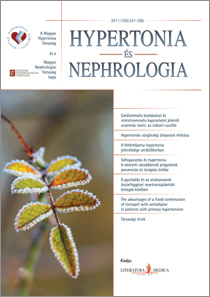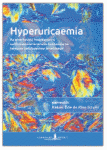The eLitMed.hu medical portal uses computer cookies for convenient operation. Detailed information can be found in the Cookie-policy.
Hypertension and nephrology - 2011;15(06)
Content
[The importance of white-coat hypertension in adolescents]
[The importance of adolescent hypertension is that there is tight correlation between blood pressure data in adolescents and in adulthood. In case of sustained adolescent hypertension increase of the left ventricular mass and the intima-media thickness of the carotid artery is also detected. The prevalence of adolescent hypertension is about 1-4%. Among them 1-41% is the frequency of white-coat hypertension. Diagnosis can be set up with repeated measurements at home, or with ambulatory blood pressure monitoring. In the background of adolescent white-coat hypertension the increased sympathetic activity has outstanding importance, which causes endothel dysfunction and increased arterial stiffness. There are growing evidence, that adolescent white coat hypertension is not a harmless condition, because sustained hypertension can develop in the future. In its case risk survey, start of non-pharmacological treatment, and follow-up has major importance.]
[Association between sleep disorders and inflammation among kidney transplant recipients]
[In patients on dialysis, the results of studies examining the association of sleep disorders and inflammation are controversial. We assessed the association between inflammatory markers and different sleep disorders in a large sample of kidney transplant recipients. In the cross-sectional study 100 randomly selected kidney transplanted patients underwent one-night polysomnography [“SLeep disorders Evaluation in Patients after kidney Transplantation (SLEPT) Study”] to diagnose obstructive sleep apnea (OSA) and periodic limb movement is sleep (PLMS). Athens Insomnia Scale (AIS) was used to assess the prevalence of insomnia. Socio-demographic information, data on medication, comorbidity and laboratory parameters were collected. Inflammatory markers such as Creactive protein (CRP), serum albumin, white blood cell count, interleukine-6 (IL-6) and tumor necrosis factor-α (TNF-α) levels were measured. The mean age was 51±13 years (43% female) and the prevalence of diabetes 19%. We found no significant difference in the levels of inflammatory markers between patients with OSA and PLMS versus (vs) patients without such disorders. Apnea-hypopnea index showed a significant association with white blood cell count (rho=0.23), and weak, non significant correlations with the other inflammatory markers (rho<|0.15|). PLM index showed weak, non significant correlations with all markers of inflammation (rho<|0.15|). The serum IL-6 level was significantly higher in patients with insomnia (AIS≥10) than in non-insomniacs [median (IQR): 3.2 (2.6-5.1) vs. 1.7 (1.2- 2.9) ng/l; p=0.009]. The levels of other inflammatory markers were similar between insomniacs and non-insomniacs. We did not find any association between the presence of objectively assessed sleep disorders and inflammatory markers in kidney transplant patients.]
[The advantages of a fixed combination of lisinopril with amlodipine in patients with primary hypertension]
[Background: The aim of the study was to examine the effect of amlodipine, lisinopril and a fixed low-dose combination of amlodipine + lisinopril on the performance of the daily profile, blood pressure variability and heart rate variability in patients with PH stage I-II, 1-2 degrees. The diagnosis of PH was made in accordance with the classification of JNC USA in 2003, ESH, ESH 2007 on the basis of careful clinical and instrumental investigations. Methods: The study included 75 PH patients who were divided into three groups depending on the medication received. The first group included 23 patients treated with lisinopril, the second included 27 patients treated with amlodipine, and the third included 25 patients receiving a fixed combination of amlodipine + lisinopril. Drugs were administered once daily with dose titration for lisinopril effective for 10 to 20 mg (mean 15.6±2.2 mg), for amlodipine 5 to 10 mg (mean 7.8±1.1 mg), and Lisonorm administered in a standard fixed dose (lisinopril 10 mg, amlodipine 5 mg), once in the morning. Controlled treatment lasted for 12 weeks. The study used daily blood pressure monitoring and ECG Holter monitoring methods. Results: A comparison of side effects found that combined therapy significantly reduced the number of adverse reactions. For all three groups, treatment resulted in a significant decrease in the average daily, daytime and night-time BP values and in the variability of systolic and diastolic BP. With combined therapy, these changes were more significant. Conclusion: These positive changes appear to be due to the fact that combination therapy can affect several parts of the pathogenetic development of hypertension, compared with the effects of monotherapy, with superior results. In the combination therapy, lisinopril levelled the sympathetic stimulation of amlodipine by blocking the activity of the sympathoadrenal and renin-angiotensin-aldosterone system.]
1.
Clinical Neuroscience
Is there any difference in mortality rates of atrial fibrillation detected before or after ischemic stroke?2.
Clinical Neuroscience
Factors influencing the level of stigma in Parkinson’s disease in western Turkey3.
Clinical Neuroscience
Neuropathic pain and mood disorders in earthquake survivors with peripheral nerve injuries4.
Journal of Nursing Theory and Practice
[Correlations of Sarcopenia, Frailty, Falls and Social Isolation – A Literature Review in the Light of Swedish Statistics]5.
Clinical Neuroscience
[Comparison of pain intensity measurements among patients with low-back pain]1.
Clinical Neuroscience Proceedings
[A Magyar Stroke Társaság XVIII. Kongresszusa és a Magyar Neuroszonológiai Társaság XV. Konferenciája. Absztraktfüzet]2.
3.
Journal of Nursing Theory and Practice
[A selection of the entries submitted to the literary contest "Honorable mission: the joys and challenges of our profession" ]4.
Journal of Nursing Theory and Practice
[End of Life and Palliative Care of Newborns in the Nursing Context]5.
Journal of Nursing Theory and Practice
[Aspects of Occupational Health Nursing for Incurable Patients ]



